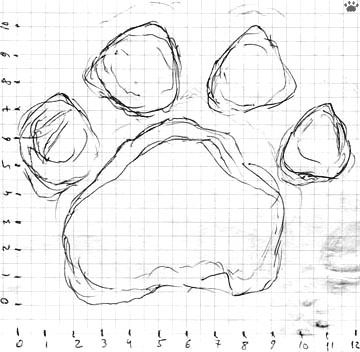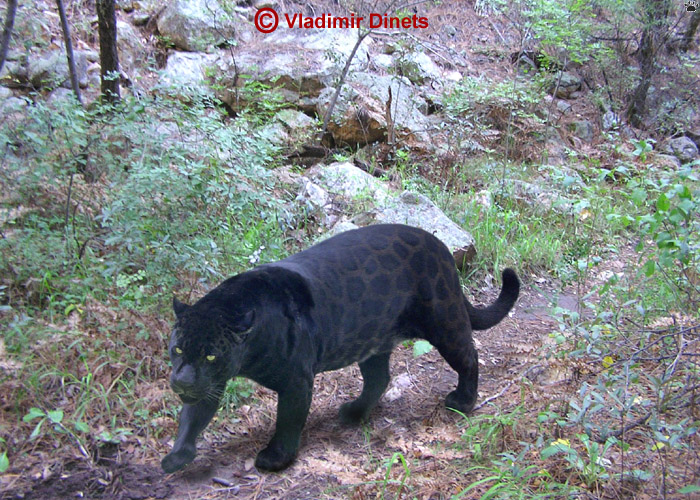
.

First documentation of melanism in the jaguar (Panthera onca) from northern Mexico
A shortened version of this paper was published in Cat News (IUCN publication),
Vladimir Dinets
Paul J. Polechla Jr.
Although the popular literature and folklore (Carmony 1995) is replete with references to melanistic jaguars (Panthera onca) and this coloration pattern has been documented in Central and South America (Meyer 1994, Brown and Lopez 2002), no scientific documentation has been provided to date to confirm the existence of a native melanistic jaguar in the northern part of their range (Brown and Lopez 2002). Place names such as the ancient city of Ek Balam, Yucatan, Mexico ("black jaguar" in Mayan language) and Cueva del Tigre Negro, Chiapas, Mexico ("cave of the black tiger or jaguar" in Spanish language) elude to the past occurrences of melanistic jaguars in southern Mexico. However, Brown and Lopez (2002) unequivocally state: "With the exception of captive animals, which are commonly bred in zoos, black or melanistic jaguars have never been documented north of Mexico's Isthmus of Tehuantepec." This paper presents the first documentation of a free-ranging melanistic jaguar in the North American portion of Mexico.
On 30 May 2004, the senior author (VD) found large felid tracks (approximately 100 mm track width, 150 mm track length, and straddle 250-350 mm, stride 400-550 mm) (measured fide Halfpenny 1986) with relatively compact shape and unlobed heel (Miller and Jug 2001, Childs 1998) in an unnamed side canyon of El Fuerte river valley near Sinaloa/Chihuahua border in the Sierra Madre Occidental, northwestern Mexico (Latitude: 27 degrees North and Longitude: 108 degrees West, elevation 1,000 m). These felid tracks were found in a few locations along a 200 m stretch of the trail. They were identified as jaguar rather than puma (Puma concolor) based on the (Miller and Jug 2001, Childs 1998). They were not very fresh, probably 3-5 days old and no high-quality photos could be obtained. However, a sketch was made of the tracks (Figure 1). This area, accessible by a sparse number of burro pack/four-wheel drive vehicle trails, was very remote and rugged (elevation range: 750-2,370 m), and had only a few human settlements and abandoned small mines. The entire canyon was heavily forested with vegetation ranging from deciduous tropical (i.e. bosque tropical caducifolio) to pine (Pinus spp.)-fir (Abies durangensis) forests (bosque de coniferas y de Quercus and bosque mesofilo de montanya) (Rzedowski 1986). The tracks were found on a game trail along a small creek bordered by a deep and narrow canyon, with dense semi-evergreen forest (i.e., bosque tropical subcaducifolio) covering the canyon floor. The walls were mostly bare rock faces up to 100 m high. Above the rocky walls, mountain slopes were covered with deciduous tropical forest with patches of unlogged oak (Quercus sp.) woodland.
The canyon narrowed considerably, restricting movement of most medium and large animals to the game trail. Numerous tracks of Coues' white-tailed deer (Odocoileus virginianus couesii), collared peccary (Tayassu tajacu), and white-nosed coati (Nasua narica) were also found.
On 3 September 2004 the site was revisited. A rain had made tracking difficult although sets of jaguar tracks were found under protected rocky overhangs. The size and shape of the tracks appeared similar to the ones seen in May, so they belonged to a jaguar of a similar size and possibly the same individual. As it seemed apparent that the trail was used by a jaguar regularly and that the next visit could be expected soon, an observation blind was established in a large hollow tree located approximately 15 m from the trail, 3-4 m higher upslope with the hollow entrance 50 cm diameter and 1 m above the ground.
The senior author was able to almost continuously observe the game trail below. It was raining throughout most of the observation period. During 62 hours of observation, the only mammals recorded were three white-tailed deer, one striped skunk (Mephitis mephitis), one Arizona cotton rat (Sigmodon arizonae), one Eastern cottontail rabbit (Sylvilagus floridanus) and numerous Mexican fox squirrels (Sciurus arizonensis). Animals recorded in the area during the two visits, but not observed from the blind included rock squirrel (Spermophilus variegatus), wood rats (Neotoma albigula, N. phenax, and N. mexicana), nine-banded armadillo (Dasypus novemcinctus), Virginia opossum (Didelphis virginianus), wild turkey (Meleagris gallopavo), spotted box turtle (Terrapene nelsoni), Mexican beaded lizard (Heloderma horridum), spiny-tailed iguana (Ctenosaura hemilopha), and common boa (Boa constrictor). Many of these animals comprise part of the diet in other parts of the jaguars distribution.
Then in the early morning of 6 September 2004, a dark, stocky, robust-skulled, female, long-tailed felid with black spots forming a rosette with a central dot was observed walking down the trail. The senior author photographed the felid using an Olympus Camedia C-740 digital camera (Figure 2). Poor light conditions made the photo appear darker than the animal actually was. Due to rain no high-quality tracks were found. The color of the background pelage color varied from smoky amber on the rump and face to bronze-black on shoulders, paws, and tail. It was a melanistic jaguar, much darker than normal lighter color phase jaguar which is described as "light ochraceous buff" (Nelson and Goldman 1933) for this region of northwestern Mexico (i.e. P. o. hernandesii or P. o. arizonensis), yet lighter in background color than wild (Rio Manu, Peru) and captive melanistic jaguars (n=10) from South America. The incidence of melanism in South American jaguars is six percent of the total population (Brown and Lopez 2001).
Several explanations could be advanced concerning the observation of this melanistic or "black phase" jaguar. This individual may have been an escapee from a zoo or "put and take game farm" as described in Belize by Brown and Lopez (2001). These possibilities are unlikely though for three reasons. The jaguar photographed is very lean. Captive individuals tend to have rolls of subcutaneous fat around their bellies. No "put and take game farms" are known from the area. The closest zoo with jaguars on display is Parque Zoologico Guadalara, Jalisco, Mexico approximately 825 Km by air from the observation point. Apparently the individual frequented the area indicating it was a resident and not a transient formerly captive animal. The individual in question could be simply a rare genetically aberrant individual in an indigenous resident population. Melanism in jaguars has now been shown to be caused by a dominant mutation of a single gene (Pocock 1929, Kitchener 1991 and Sunquist and Sunquist 2002). Thus, melanism has been reported from a total of 13 of 36 species and 9 of 18 genera of the family Felidae (Wozencraft 1993) including (besides the jaguar): the leopard (Panthera pardus), lion (P. leo), tiger (P. tigris), caracal (Caracal caracal), tiger cat (Leopardus tigrinus), puma (Puma concolor), bobcat (Lynx rufus), margay (Leopardus wiedii), ocelot (L. pardalis), serval (Leptailurus serval), sand cat (Felis margarita), and kodkod (Oncifelis guigna). Brown and Lopez (2001) note a black jaguar from the southern Mexican state of Chiapas but provide no documentation. Brown and Lopez (2001) and Meyer (1994) provide photos of hunter-killed melanistic jaguars from Belize. This is a northern extension of observed melanism in the species of between 1,925 to 2,100 km. Our record then constitutes the northernmost documentation of a melanistic jaguar in their entire range in the wild.


Literature Cited
Brown, D.E. &. Lopez-Gonzalez, C.A. 2000. Notes on the occurrences of jaguars in Arizona and Mexico. The Southwestern Naturalist 45:537-546.
Brown, D.E. & Lopez-Gonzalez, C.A. 2001. Borderland jaguars: tigres de la frontera. University of Utah Press, Salt Lake City, UT 170 pp.
Carmony, N.B. 1995. Onza! The hunt for a legendary cat. High Lonesome Books, Silver City, NM 204 pp.
Childs, J.L. 1998. Tracking the felids of the borderlands. Printing Corner Press, El Paso, TX. 77 pp.
Halfpenny, J. 1986. A field guide to mammal tracking in western America. Johnson Books, Boulder, CO, 161 pp.
Kitchener, A. 1991. The natural history of the wild cats. Cornell University Press, Cornell, NY. 280 pp.
Lopez -Gonzalez, C.A. & D.E. Brown. 2002. Distribucion y estado de concervacion actuales del jaguar en el noreste de Mexico. Pp. 379-391. In El jaguar en El nuevo milenio. R. A. Medellin et al. (eds.) Fondo de Cultura Economica, Mexico D.F., Mexico. 647 pp.
Meyer, John R. 1994 Black jaguars in Belize? A survey of melanism in the Jaguar, Panthera onca. http://biological-diversity.info/Black_Jaguar.htm
Miller, CM, Jug, G. 2001. Measurements of jaguar tracks: a promising means to identify individuals. Track collection protocols. http://savethejaguar.com/media/file/PhotoProtocolRevised%207.11.01.pdf
Nelson, E.W. & E.A. Goldman. 1933. Revision of the jaguars. Journal of Mammalogy 14:221-240.
Pocock, R.I. 1929. Tigers. Journal of the Bombay Natural Historical Society 33:505-541.
Rzedowski, J. 1986. Vegetacion de Mexico. Editorial Limusa. Mexico D.F., Mexico. 432 pp.
Sunquist, M. & F. Sunquist. 2002. Wild cats of the world. University of Chicago Press, Chicago, IL. 452 pp.
Wozencraft, W.C. 1993. Order Carnivora. Pp. 279-348. In Mammalian species of the world: a taxonomic and geographic reference. DE Wilson and D.M. Reeder (eds.), Smithsonian Institution Press, Washington, D.C., 1206 pp.